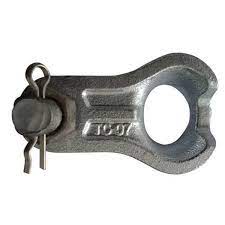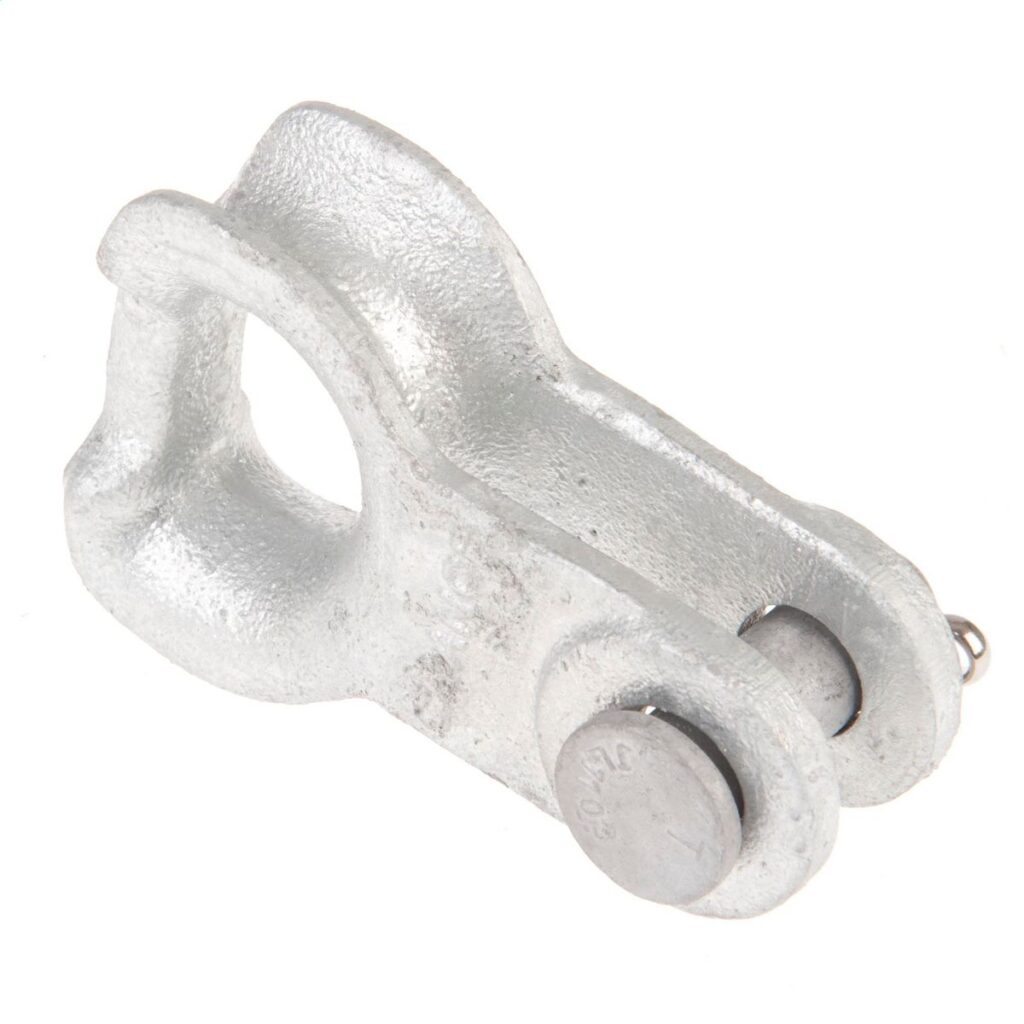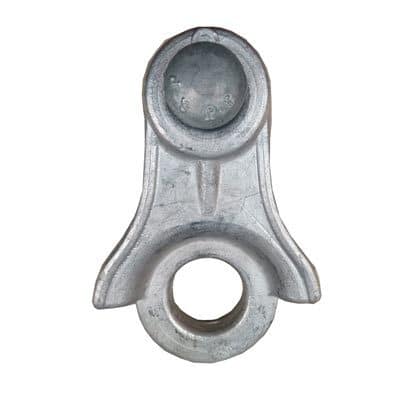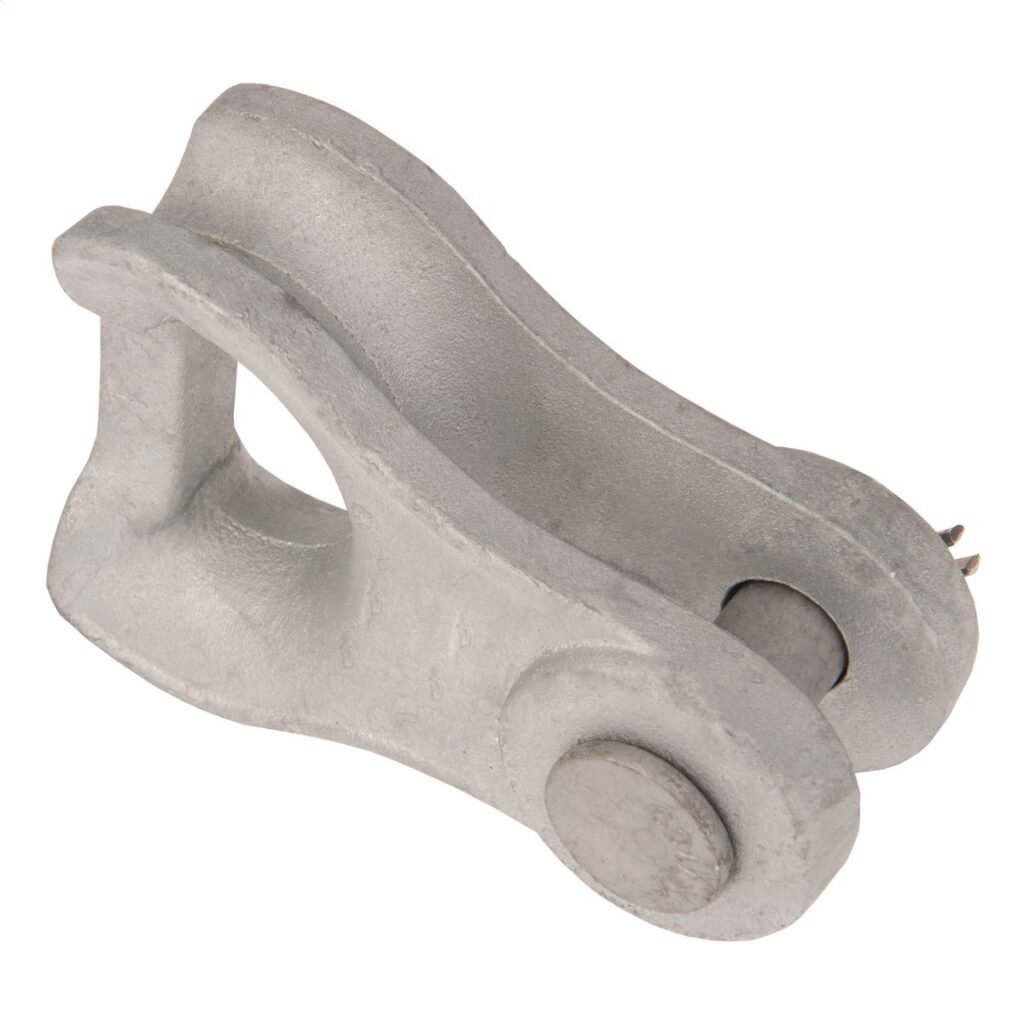A thimble clevis is a component used in overhead power line construction and maintenance. It helps to connect a dead-end insulator or suspension insulator to the crossarm or tower. It has a specific shape that resembles a thimble with a loop at one end and a clevis pin hole at the other end. The loop helps to attach the insulator while the clevis pin hole end helps to secure the thimble clevis to the crossarm. Using thimble clevises provides mechanical support and stability to the power line. They also ensure the insulators attach to the support structure and allow easy installation. Thimble clevises are from durable and high strength materials for longevity. These materials include steel, galvanized steel, aluminum or composite materials. They find use in applications such transmission lines, distribution and telecommunication lines.
Fittings that work with thimble clevis
The clevises work with other fittings and accessories in power line applications. They help to ensure proper installation, support and functionality. Use of these fittings also ensures performance and durability of the specific application. Additionally, it is advisable to ensure you have all the necessary tools and fittings for your application needs. The following are the key fittings used with thimble clevises.

- Clevis pin – clevis pins are components used to secure thimble clevises to crossarms, poles or other support structures. They pass through the clevis pin hole in the thimble clevis and secure in place with cotter pins.
- Insulators – the clevises attach to insulators which help to isolate the conductors from the support structure.
- Strain hardware – the clevises work with strain hardware to absorb and distribute mechanical loads. This includes components such as dead-end clamps, guy wire clamps and vibration dampers.
- Protective hardware – the clevises work in guy wire clamps, thimbles and guy anchors to anchor and tension guy wires.
- Dead-end hardware – thimble clevises work in assemblies where they connect to dead-end insulators. They include components such as dead-end clamps, anchor shackles and guy wire hardware. These components help provide mechanical support.
- Crossarm and brackets – the clevises mount on crossarms or brackets attached to utility poles or towers. They provide support for thimble clevises and help distribute the mechanical loads across the structure.
- Guying hardware – the clevises also work in guyed structures to provide extra support and stability. they include components such as guy wire clamps, thimbles and guy anchors.
- Connectors and splice – the clevises work with connectors and splices to join conductors to underground cables. They provide reliable electrical connections while maintaining the mechanical integrity of the system.
Performance characteristics of thimble clevis
There are various ways to assess the performance of the thimble clevis in your applications. There are various factors that influence the performance of the thimble clevis. The factors are as discussed below.

- Strength – the clevises have designs to withstand mechanical loads and stresses. This is mostly from tension, compression and bending. Manufacturers should provide specifications about the greatest load capacity and ultimate strength of the clevises.
- Accuracy – thimble clevises should have precise dimensions to ensure proper fit and compatibility with other power line systems. Dimensional accuracy contributes to ease of installation and maintenance.
- Ease of installation – the clevis has a design to ease installation and assembly on the power line structure. This helps to reduce downtime during construction or maintenance.
- Material – the clevises are from high-strength, corrosion resistant materials for longer service life. These materials include galvanized steel or aluminum alloy. The choice of the material impacts the durability and reliability of the clevis.
- Corrosion resistance – the power lines face various conditions such as moisture, salt and chemicals. Thimble clevises should be corrosion resistant to maintain their structural integrity.
- Fatigue resistance – conditions such as dynamic loads and vibrations can induce fatigue. The clevises should have designs to resist fatigue and failure to maintain their performance.
- Compatibility – the clevises should be compatible with different types of insulators and hardware. This is to ensure proper alignment and connection without compromise.
Technical specifications for thimble clevis
Technical specifications for thimble clevises help to ensure product quality, safety, performance and compliance. They contribute to the success of the projects and satisfaction of customers. Technical specifications can vary depending on the manufacturer and the specific application requirements. Additionally, it is advisable to consult with product documentation from suppliers for accuracy. The following are the various technical specifications for thimble clevises.
| Part No. | A (Inch) | B (Inch) | C (Inch) | Ultimate Strength (KN) | Weight (Kg/Pcs) |
| F0650 | 3 1/4 | 3/4 | 5/8 | 50 | 0 480 |
| F0670 | 34/7 | 7/8 | 5/8 | 70 | 0690 |
| F06120 | 4 3/8 | 7/8 | 3/4 | 120 | 1.170 |
- Material – the clevises are from high strength and corrosion resistant materials. These materials include galvanized steel or aluminum alloy.
- Dimensions – thimble clevises are available in various sizes to accommodate different power line configurations. Dimensions include length, width, diameter of the loop and diameter of the clevis pin hole.
- Design features – the clevises include specific design features to enhance performance and ease of installation. These include reinforced construction for extra strength, rounded edges to reduce stress concentrations and smooth surfaces to reduce abrasion.
- Operating temperature range – thimble clevises should have designs to operate within a specified temperature range. This list to ensure performance and durability in various environmental conditions.
- Load capacity – manufacturers provide specifications about the greatest working load limit. This is to show the greatest load that the clevis can support in normal conditions.
- Finish – the clevises often have a protective finish coating to enhance corrosion resistance. This may include hot-dip galvanization or zinc plating.
- Manufacturer information – specifications should include information about the manufacturer, part number and other relevant details for identification.
Industry advancements and updates for thimble clevises
Thimble clevises play a vital role in ensuring the structural integrity and reliability of the system. Development of new technologies help to improve the reliability and performance of the clevises. The advancements help to ensure the reliability, safety and efficiency of power systems. Additionally, it is advisable to consult with experts for guidance on the best advancements for thimble clevises. This is also depending on your specific application needs. The following are the common advancements and updates in the thimble clevis industry.

- Improved performance – there is advancements in material science, manufacturing techniques and design engineering. They include higher load capacities, increased durability, improved corrosion resistance and better fatigue resistance.
- Efficiency and cost effectiveness – the advancements lead to more efficient installation and maintenance processes. They also reduce downtime and labor costs related to power line construction. They innovations also help improve the lifespan and performance of thimble clevises.
- Compatibility and interoperability – advancements address compatibility issues ensuring seamless integration and interoperability.
- Risk management – the advancements help utilities and power companies to mitigate risks related with outdated clevis technology. This helps reduce the likelihood of equipment failures, power outages and liabilities.
- Safety and compliance – the advancements incorporate improvements to meet or exceed safety standards and regulatory requirements. these changes ensure the thimble clevises follow the latest industry standards to help enhance safety.
- Innovation and differentiation – companies may differentiate themselves through innovation introducing unique features. They help provide extra value to customers and allow utilities and power companies to explore new products.
Challenges and issues facing use of thimble clevises
Thimble clevises used in power line construction, face various challenges and issues related to their use. The challenges and issues revolve around safety, reliability and environmental considerations. Addressing these challenges requires ongoing efforts in research, development and innovation. This is to improve the design, materials and manufacturing processes. Also, proper installation and maintenance practices helps to ensure the safe operation of the clevises. The following are the various challenges and issues facing the use of thimble clevises.

- Corrosion and weathering – the clevises face conditions such as moisture, salt and UV radiation. Corrosion compromises the structural integrity of the clevises. This may in turn lead to equipment failure and safety hazards.
- Overloading and overstressing – overloading of thimble clevis can lead to overstressing. This can result in cracking, deformation or shearing of the clevises.
- Insulator damage – improper handling of thimble clevises can cause damage to insulators. This in turn affects their electrical insulation properties. Damage can lead to electrical faults, power outages and safety hazards.
- Fatigue and mechanical stress – the clevises are subject to mechanical stresses and dynamic loads in areas with high winds. Repeated stresses can cause fatigue and deformation in the clevises increasing the risk of failure.
- Compatibility issues – the clevises must be compatible with other components of the power line system. This is including insulators, crossarms and hardware.
Frequently asked questions
A thimble clevis is a component used in overhead power line construction to connect insulators to support structures. It helps to provide mechanical support and stability to the power line system.
Corrosion can compromise the structural integrity of thimble clevises leading to equipment failure and safety hazards. Measures to mitigate corrosion include corrosion resistant materials, applying protective coatings and implementing regular inspections.

